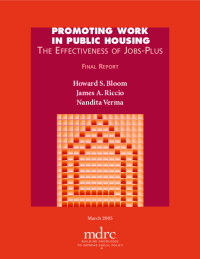Promoting Work in Public Housing
The Effectiveness of Jobs-Plus
Can a multicomponent employment initiative that is located in public housing developments help residents work, earn more money, and improve their quality of life? The Jobs-Plus Community Revitalization Initiative for Public Housing Families (Jobs-Plus, for short) sought to achieve these goals at selected public housing developments in six cities: Baltimore, Chattanooga, Dayton, Los Angeles, St. Paul, and Seattle. Jobs-Plus was conducted as a research demonstration project from 1998 to 2003 with sponsorship from a consortium of funders, led by the U.S. Department of Housing and Urban Development and the Rockefeller Foundation. The program — which was targeted to all working-age, nondisabled residents of selected public housing developments and implemented by a collaboration of local organizations — had three main components: employment-related services, rent-based work incentives that allowed residents to keep more of their earnings, and activities to promote neighbor-to-neighbor support for work. This final report on MDRC’s evaluation of Jobs-Plus describes the program’s impacts, that is, the difference it made for residents in Jobs-Plus developments in comparison with residents living in similar developments who did not receive the program.
Key Findings
- Four of the six study sites built substantial Jobs-Plus programs — although it took over two years to accomplish.
- Once Jobs-Plus was in place at the four sites, it markedly increased the earnings of residents (including those who eventually moved away) relative to the comparison group. This impact was sustained over time at three of the sites but disappeared at the fourth when its residents were displaced by a federal HOPE VI renovation project. There was no program effect on earnings at the two sites that did not fully implement Jobs-Plus. The effects of Jobs-Plus on employment were positive at the sites that substantially implemented the program but were smaller and less consistent than the effects on earnings.
- The large positive earnings effect of Jobs-Plus in the stronger implementation sites held for a wide range of residents defined in terms of their gender, race or ethnicity, age, past employment, past welfare receipt, past duration of residence, and future resident mobility. Most striking were the especially large impacts for immigrant men.
- Welfare receipt by residents dropped precipitously after Jobs-Plus was launched, but this decline was not related to Jobs-Plus.
- The positive effects on individual earnings were more likely to translate into more earnings across the housing development as a whole in sites where fewer residents moved out. However, these effects did not spark changes in overall social conditions or quality of life in the developments.
These and other findings in the report offer important lessons to policymakers and program administrators about how to increase the economic self-sufficiency of public housing residents.






